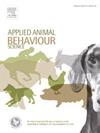The difference in roaming behavior between owned and unowned dogs in a satoyama landscape area
IF 2.2
2区 农林科学
Q1 AGRICULTURE, DAIRY & ANIMAL SCIENCE
引用次数: 0
Abstract
The One Health approach aims to achieve the joint health of humans, animals, and the environment, which will contribute to human survival and ecosystem sustainability. One of the major threats to One Health is free-roaming dogs, including owned unrestricted dogs and unowned dogs, which are common in many areas of the world and can potentially transmit diseases to humans and wildlife. Studying their roaming behavior can help evaluate the epidemic patterns of dog-caused infectious diseases. However, previous studies on roaming behavior have focused mainly on owned dogs. In this study, we aimed to examine and compare the roaming patterns of both owned and unowned dogs. We hypothesized that unowned dogs, which have no stable food sources and home to rely on, will exhibit greater roaming behavior than will owned dogs. By using a global positioning system (GPS) tracking technique, a total of 12 owned dogs and 10 unowned dogs were tracked during 2019–2021 in Yangmingshan, Taiwan, which is a satoyama landscape area. Generalized linear model analyses suggested that the most important factor influencing roaming behavior was ownership status, with unowned dogs having a 742 % larger home range size (163.3 ± 135.3 ha versus 22.0 ± 23.5 ha; mean ± SD), 867 % larger core area size (5.2 ± 5.5 ha versus 0.6 ± 0.4 ha), 5800 % farther distance from artificial environments (58 m versus 1 m; median), and a 529 % higher proportion using natural environments (68.3 ± 16.0 % versus 12.9 ± 8.8 %) than owned dogs. We found no detectable effect of sex, sterilization status, or weight. In addition, unowned dogs were closer to roads and artificial environments on weekends than on weekdays, probably due to human activities attracting them, while owned dogs did not show temporal variation in space use. Our results clearly suggest that dogs' roaming behavior is mainly affected by human factors. The range of roaming for unowned dogs was wider and more in-depth in natural environments than that for owned dogs, potentially posing greater risks to public health and wildlife conservation. Decreasing the number of unowned dogs and improving responsible ownership would be the primary management objectives in satoyama landscapes to achieve the One Health goal.
求助全文
约1分钟内获得全文
求助全文
来源期刊

Applied Animal Behaviour Science
农林科学-行为科学
CiteScore
4.40
自引率
21.70%
发文量
191
审稿时长
18.1 weeks
期刊介绍:
This journal publishes relevant information on the behaviour of domesticated and utilized animals.
Topics covered include:
-Behaviour of farm, zoo and laboratory animals in relation to animal management and welfare
-Behaviour of companion animals in relation to behavioural problems, for example, in relation to the training of dogs for different purposes, in relation to behavioural problems
-Studies of the behaviour of wild animals when these studies are relevant from an applied perspective, for example in relation to wildlife management, pest management or nature conservation
-Methodological studies within relevant fields
The principal subjects are farm, companion and laboratory animals, including, of course, poultry. The journal also deals with the following animal subjects:
-Those involved in any farming system, e.g. deer, rabbits and fur-bearing animals
-Those in ANY form of confinement, e.g. zoos, safari parks and other forms of display
-Feral animals, and any animal species which impinge on farming operations, e.g. as causes of loss or damage
-Species used for hunting, recreation etc. may also be considered as acceptable subjects in some instances
-Laboratory animals, if the material relates to their behavioural requirements
 求助内容:
求助内容: 应助结果提醒方式:
应助结果提醒方式:


